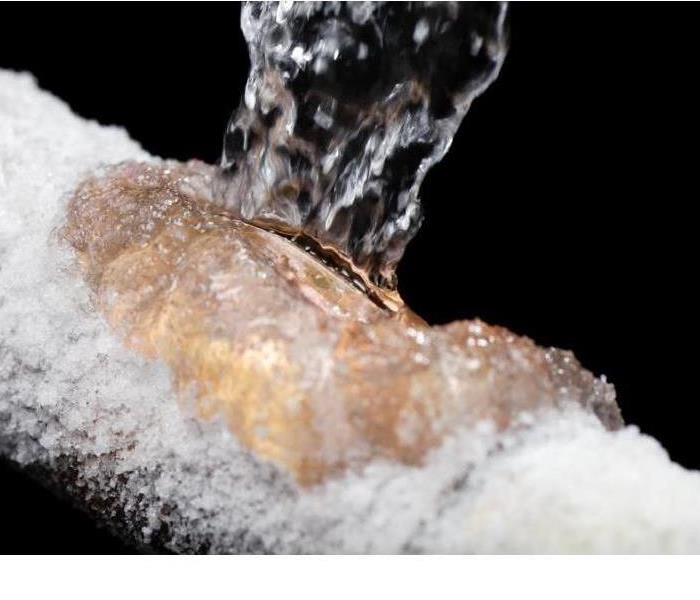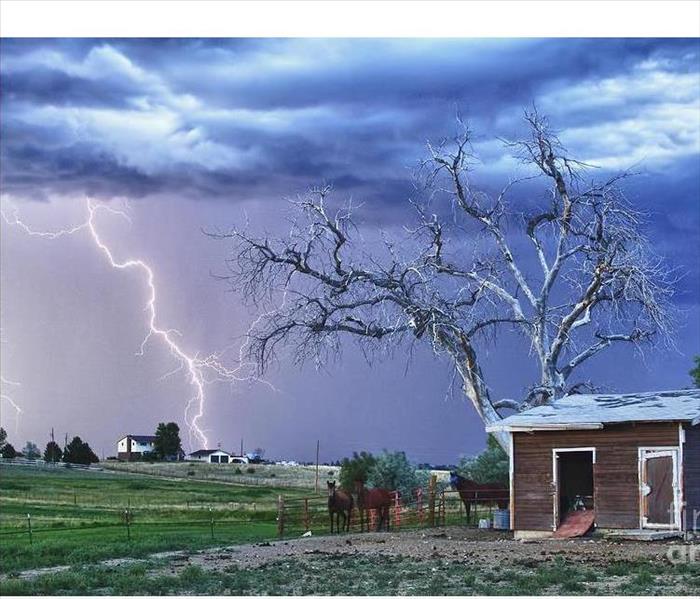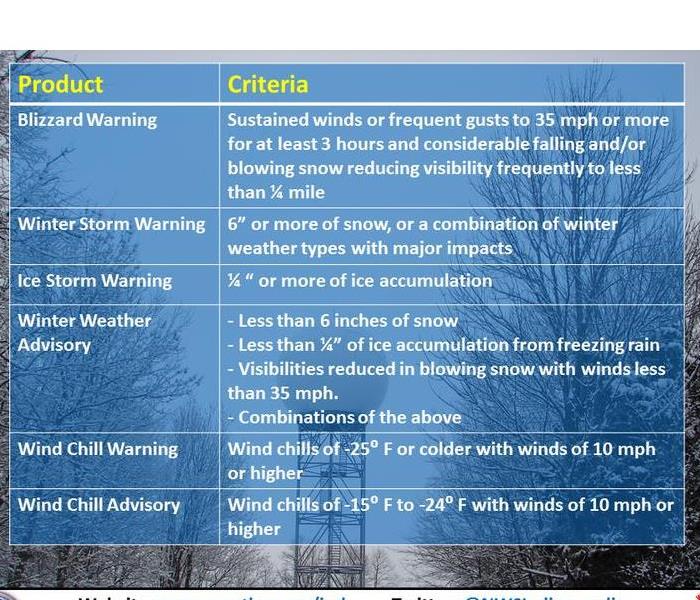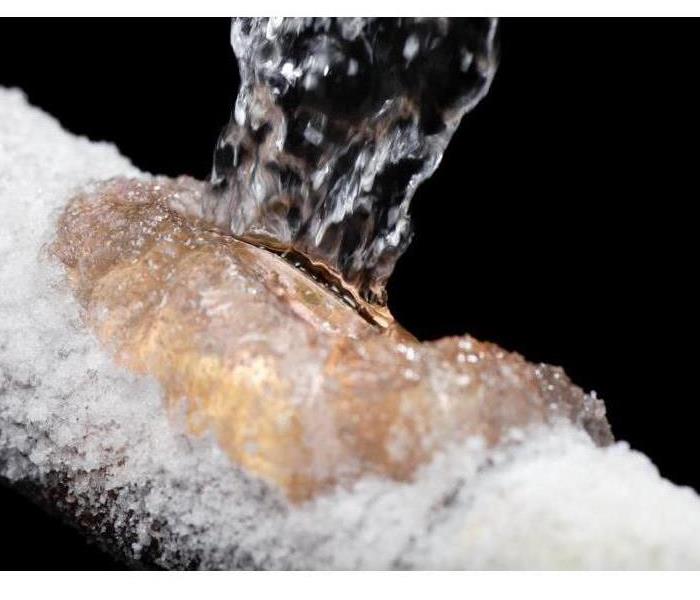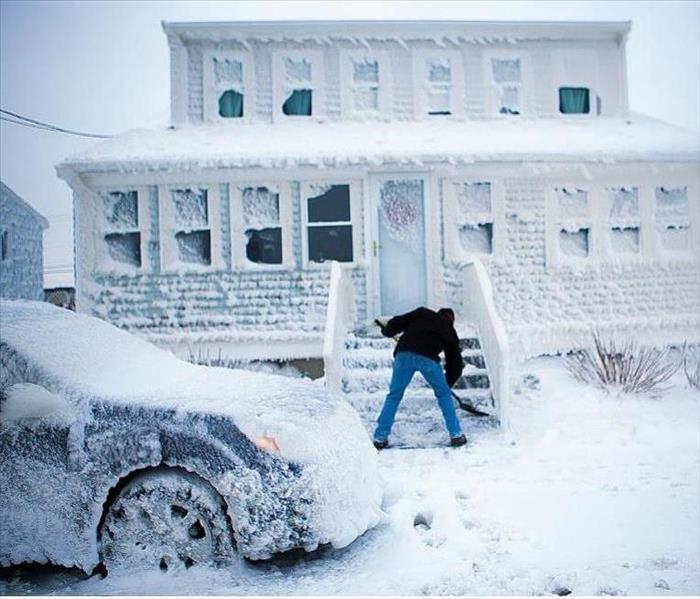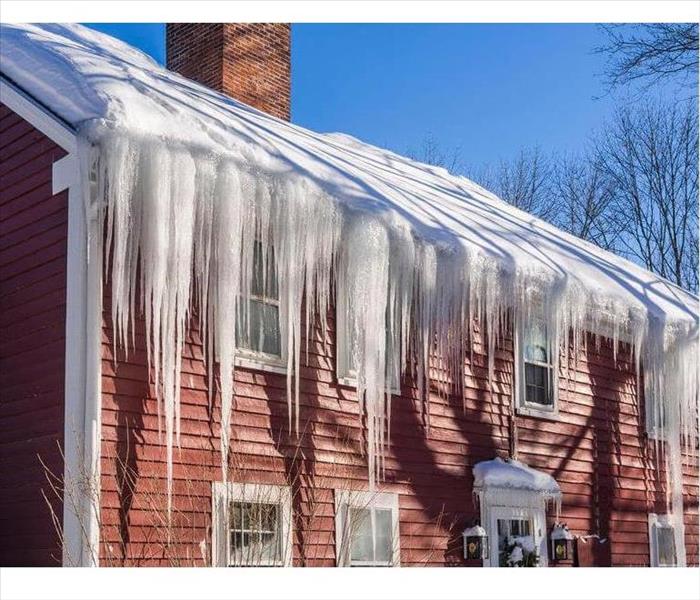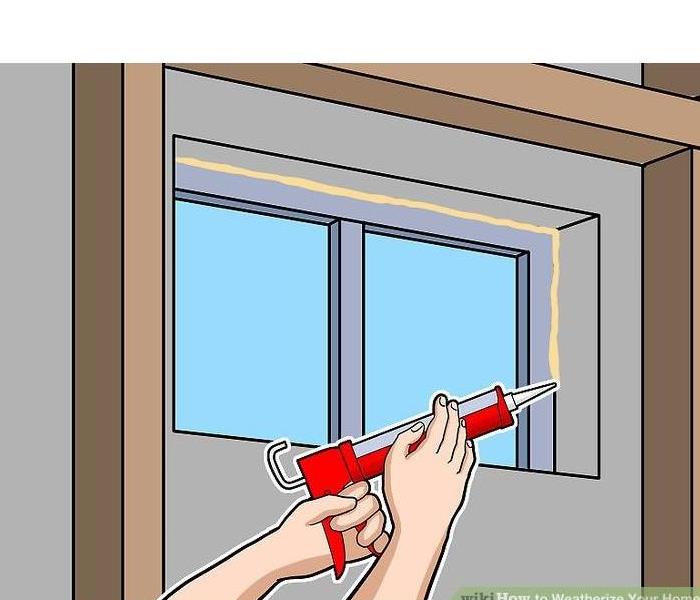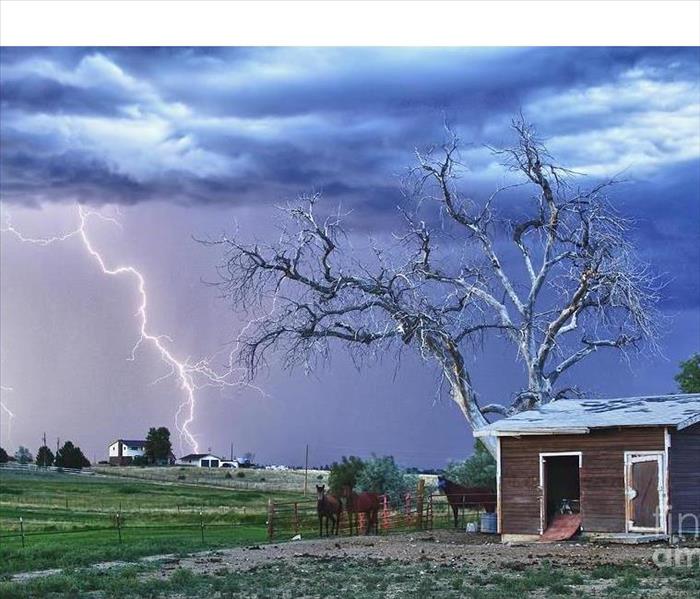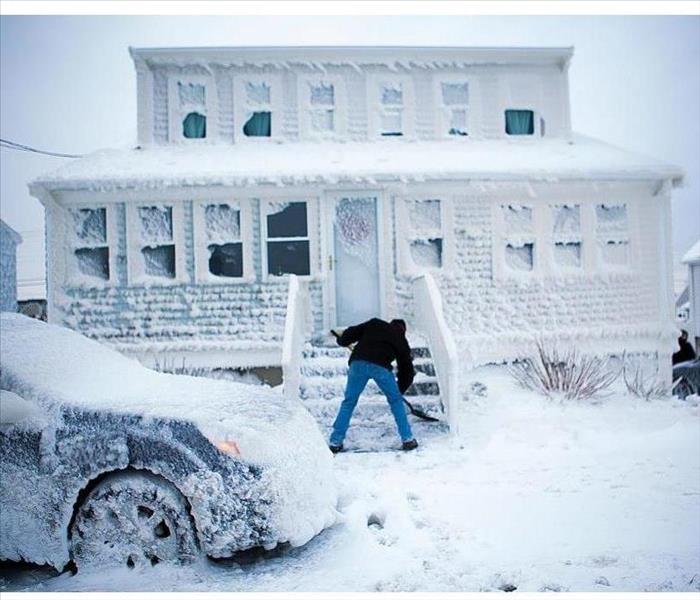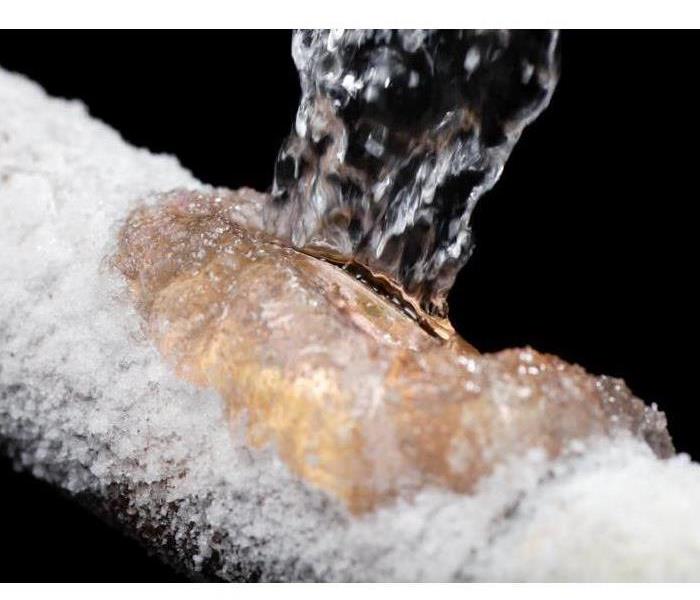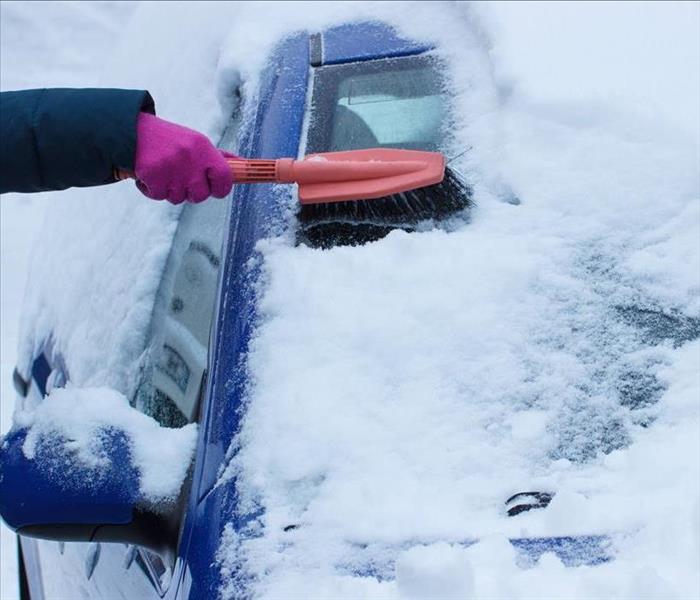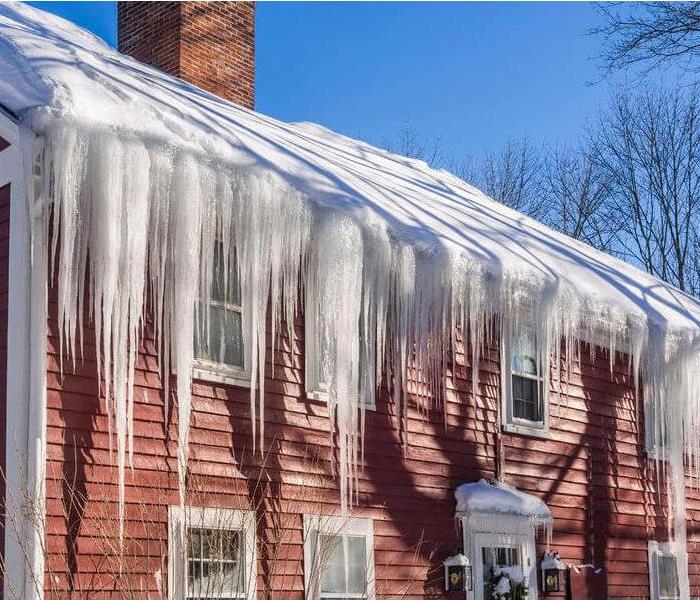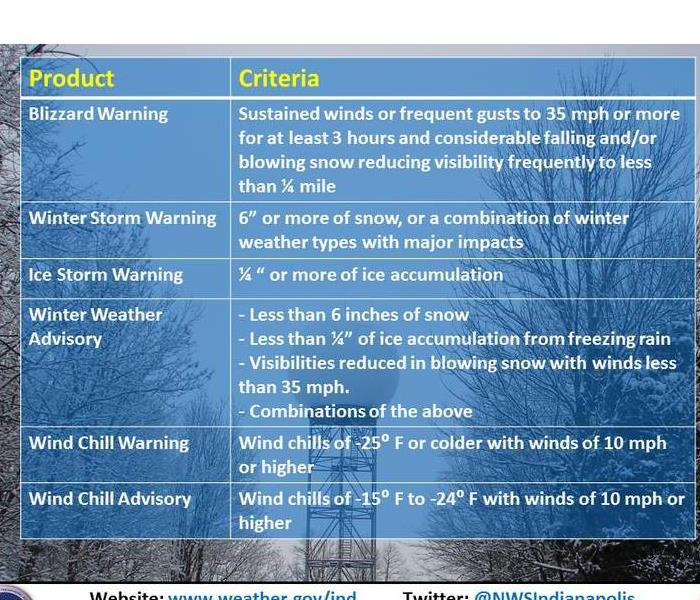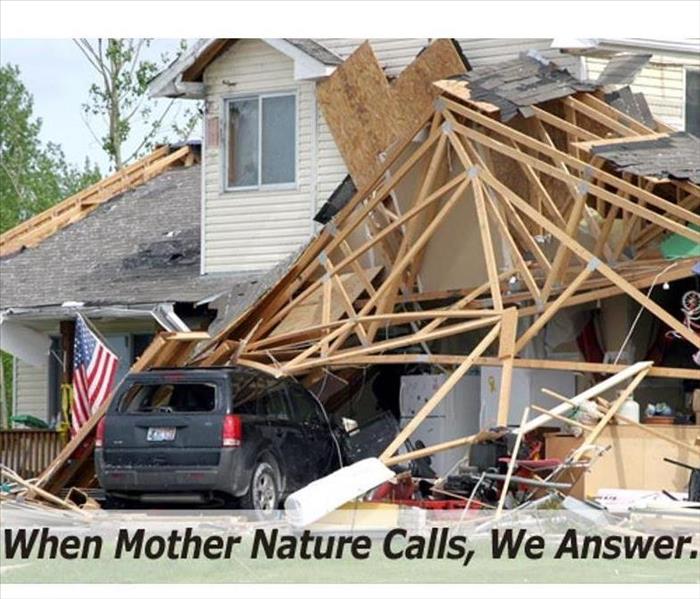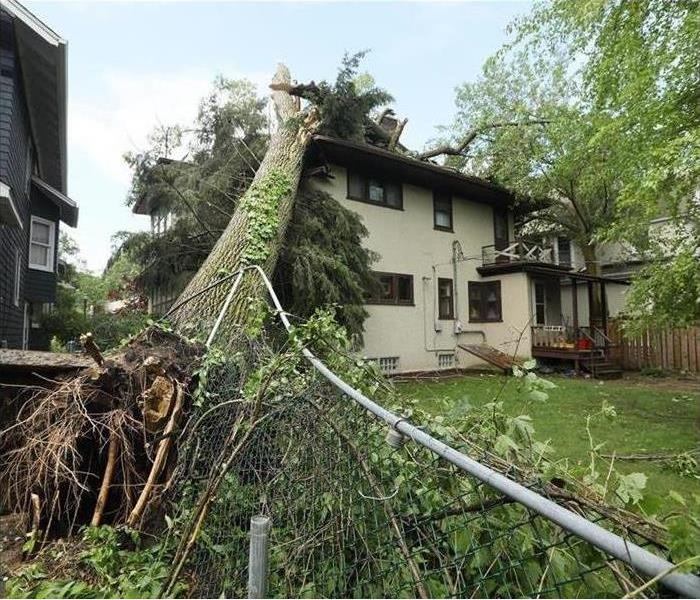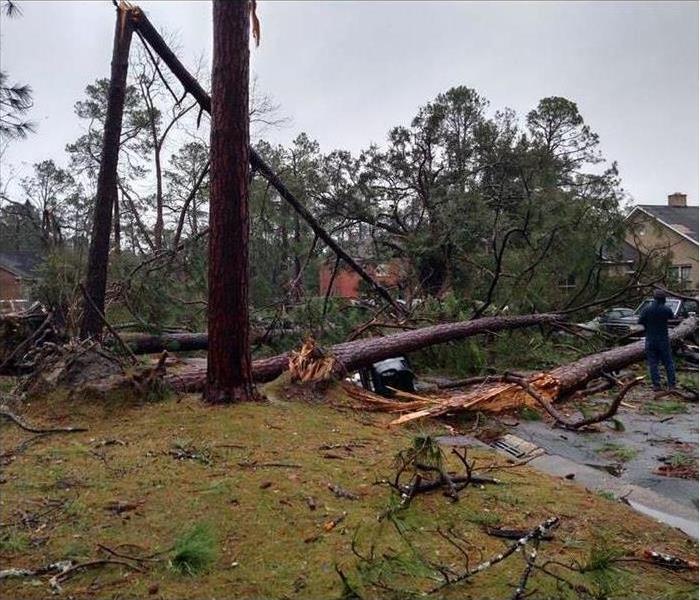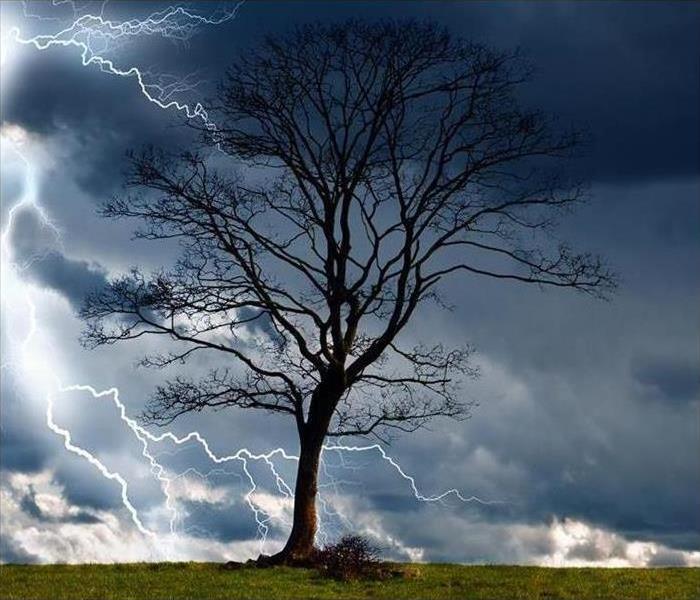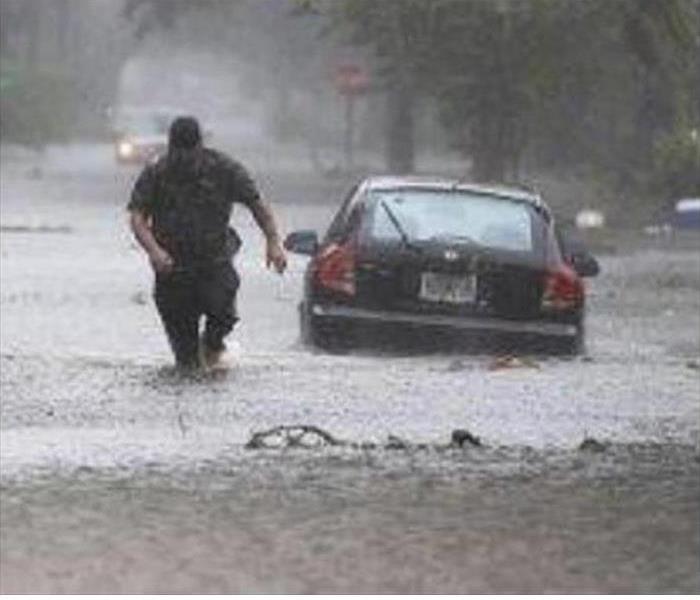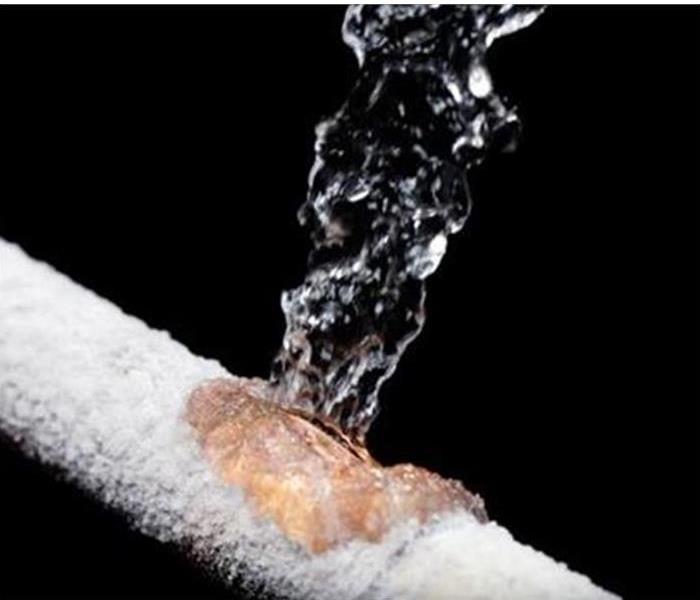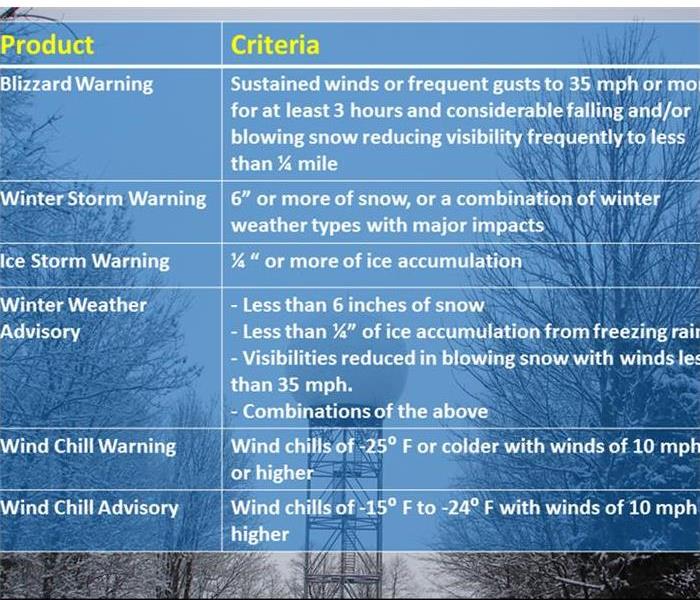Archived Storm Damage Blog Posts
Wind & Storm Damage
4/12/2022 (Permalink)
There are many areas of the United States that have experienced heavy winds and storms this season and the strong powerful winds can cause significant damage to a home. Wind damage and water damage are the most common results of a heavy storm and it is important to contact SERVPRO as soon as the storm is over to help limit and repair the damage. Wind damage can happen to your home directly from the strong wind or indirectly from the wind blowing debris into your house. These wind damage facts will help you better understand the potential for wind damage and how to prevent it.
Storm Damaged Roof
Wind Type Varies by Storm and Causes Different Degrees of Wind Damage
Thunderstorms are the most common source of wind and storm damage but winds from hurricanes or tornadoes are stronger and can cause more severe damage. It is important to know when a storm is approaching your area and what type of storm it is so you know the potential and level of damage to expect. Thunderstorms are responsible for over half of all wind damage cases in the U.S. but storm damage repair may be more costly for hurricane or tornado wind damage.
Characteristics of the Wind Affect the Wind Damage
The wind has many characteristics that differ depending on the situation. Some characteristics to take into account include speed, direction, and duration of the gusts, and recognizing them can help you protect your home and property effectively from wind damage. Recognizing the characteristics of the wind can also help you determine how much potential damage to expect.
Preventing Wind and Storm Damage
Most wind damage is caused by flying debris either from plants or other structures and objects that are not secured. If a storm is approaching your area, make sure any potential debris around your home such as patio furniture, toys, garbage cans, and other objects are secured or brought inside. Your doors and windows should also be secured to help minimize the potential storm damage to the home.
Wind and Storm Damage Repair Costs
Wind damage can cause a range of destruction to your property from broken windows and fallen tree branches to more severe damage to the roof, garage, or car. Billions of dollars are spent on wind damage repair and storm damage restoration each year and understanding the nature of wind damage can help you limit the amount of damage to your home and save on restoration and repair costs. The cost of wind damage repair generally ranges from about $880 to almost $11,000 with most homeowners spending on average between $4,600 and $7,000 for repairs. Make sure to contact SERVPRO for an estimate on the wind damage repair for your home.
Wind damage from different types of storms is a major cause of destruction to homes and by understanding the characteristics of wind damage, you can help keep your home protected during a storm. Different types of storms bring different types of winds and the storm damage caused by the wind can range from minor damage to more costly structural damage. If your home sustains wind damage during a storm, make sure to call SERVPRO immediately. These qualified technicians can provide effective wind damage and storm damage repair.
Please give us a call at 757-934-8404.
Severe Weather Myths & Facts
4/12/2022 (Permalink)
Myth: Highway and interstate overpasses are safe shelters against a tornado.
Fact: Overpasses can concentrate the tornado winds, causing them to be significantly stronger. This places the people under them in an even more dangerous situation. In recent years, several people seeking shelter beneath overpasses have been killed or severely injured. Being above ground level during a tornado is dangerous.
Myth: The low pressure of a tornado causes buildings to explode. Opening the windows will equalize the pressure, saving the building.
Fact: Opening the windows in an attempt to equalize pressure will have no effect. It is the violent winds and debris that cause most structural damage. It is more important for you to move to a safe area away from windows and exterior walls. With a tornado, every second counts, so use your time wisely and take cover.
Myth: Thunderstorms and tornadoes always move from west to east.
Fact: More often than not, thunderstorms move from west to east. Conditions in the atmosphere dictate how and where storms will move, and it can be in any direction. Tornadoes have been known to act erratic and can change directions and speed very quickly. Never try to outrun a tornado in a vehicle.
Myth: It’s not raining here, and the skies above me are clear, therefore I am safe from lightning.
Fact: Lightning can strike many miles away from a thunderstorm. If storms are in your area, but skies happen to be clear above you, that certainly does not imply you are safe from lightning. Though these “Bolts from the Blue” are infrequent, lightning strikes 10 to 15 miles away from the storm are not out of the question.
Myth: Since I am inside my house and out of the storm, I am completely safe from lightning.
Fact: Just because you have taken shelter inside, you are not automatically safe. While inside waiting out a storm, avoid using the telephone or electrical appliances and do not take showers or baths. Also, stay away from doors and windows. Telephone lines, cords, plumbing, even metal window, and door frames are all lightning conductors and pose a threat
Myth: Large and heavy vehicles, such as SUVs and pickups, are safe to drive through floodwaters.
Fact: It is a common belief that the larger the vehicle, the deeper the water it can drive through. Many people do not realize that two feet of water can float most vehicles, including SUVs and pickups. If the water is moving rapidly, vehicles can be swept away.
Myth: Flash floods only occur along flowing streams.
Fact: Flash floods can and do occur in a dry creeks or river beds as well as urban areas where no streams are present.
Winter Warnings Vs. Advisories
2/1/2022 (Permalink)
SERVPRO of Suffolk/Smithfield/Franklin wants to help you to be prepared for the upcoming winter weather. The National Weather Service will issue advisories and warnings. It is important that you understand these and know how to prepare for winter and to be Winter Safe.
- Blizzard Warning- Winds or gusts to 35 mph or more for at least 3 hours and lots of falling or blowing snow reducing your visibility to less than ¼ mile.
- Winter Storm Warning- 6” or more of snow, or a combination of winter weather types with major impacts.
- Ice Storm Warning- ¼” or more of ice accumulation.
- Winter Weather Advisory- Less than 6” of snow, Less than ¼” of ice accumulation from freezing rain, Visibilities reduced in blowing snow with winds less than 35 mph, Combinations of these.
- Wind Chill Warning- Wind chills of -25°F or colder with winds of 10 mph or higher.
- Wind Chill Advisory- Wind chills of -15°F to -24° with winds of 10 mph or higher.
Call SERVPRO of Suffolk for all your winter storm needs at 757-934-9404.
Ice Dams- Winter Weather Threat
2/1/2022 (Permalink)
Ice dams can be a major problem during the winter season. Cold weather, snow, and ice storms can cause severe damage to your home or your office.
Ice dams form when the heated air melts the roof snow downward and the melted water runs into ice that is still frozen causing the water to dam up. When this water is trapped, it can not flow or run into the gutter system and can backflow under the roof shingles and into the interior structure of your house or business.
Ice Dam damage:
- Water can seep into your home or building’s walls, ceilings, insulation, and other interior areas.
- Ice dams can lift roof shingles causing water to leak into your home.
- Pressure and weight from the dams can pull off your gutters and lead to structural damage.
Our friends at Nationwide blog about Preventing Ice Dam Damage to Your Roof and Home.
If this disaster strikes, you need to take immediate action to prevent additional damage to your property. SERVPRO of Suffolk/Smithfield/Franklin franchise professionals have the winter storm experience and expertise, and the resources to remediate damage caused by winter weather. 757-934-8404
Winter Weather - Ways to be Prepared
2/1/2022 (Permalink)
Cold weather can have a huge impact on your home or business if you are not properly prepared. Whether it is heavy rain, freezing temperatures, damaging winds, sleet, or snow, all can cause serious property damage. While you can't control the weather, you can take steps to be prepared and help take the sting out of winter weather.
To help prevent costly damages due to weather, consider taking the following actions before the harsh winter weather hits.
Check your business property for downed tree limbs and branches. Weather such as wind, heavy rain, ice, and snow, can cause damage to the property as well as potential personal injuries.
Inspect property, especially walkways and parking lots, for proper drainage to alleviate flood hazard potential.
Inspect all handrails, stairwells, and entryways to address and correct potential slippery or hazardous areas. Install mats or non-slip surfaces and post caution signs where water could be present.
Roofs, water pipes, and gutters should all be inspected to ensure they are in proper order. Gutter downspouts should be directed away from your building. Clear gutters of debris that may have gathered during the fall. Leaves and other obstructions can lead to a damming effect, that can cause roof damage and interior water problems.
Protect water pipes from freezing by simply allowing water to drip when temperatures dip below freezing. If pipes are under a cabinet, leave cabinet doors open, allowing warm air to circulate around the pipes. If the building has outdoor faucets, consider shutting the water off at the main valve in the basement or crawl space. Once the valve is off, open the outdoor faucet to ensure it drains, preventing any remaining water from freezing in the pipe.
Ask your SERVPRO of Suffolk professionals about completing an Emergency READY Profile (ERP) for your business. The ERP is a no-cost assessment of your facility and provides you with a plan to get back in business fast following a disaster.
SERVPRO of Suffolk/Smithfield/Franklin
757-934-8404
Snowstorm Car Safety
2/1/2022 (Permalink)
Snow is a lot like liver and onions. You either love it or hate it. But, if you find yourself stranded in your vehicle in the middle of a snow event, you can either hate the fact that you weren't prepared for it or love that you are.
S'now what...
Mother nature can be a real beast. In fact, she's a killer. And when it comes to a snow event, the best idea for safety is to stay off the roads and keep warm and safe at home. However, that isn't always possible. When you find that you must venture out on snowy and icy roads, you know to stay alert, drive a little slower, brake according to road conditions... But what if your vehicle breaks down or gets stuck and you must wait for help in a disabled vehicle in dangerously cold, wet weather?
SERVPRO of Suffolk/Smithfield/Franklin wants you to be prepared in the face of any hazard that may cross your path, whether flood, fire or treacherous travel conditions.
Please take a moment to look at the list (below) of suggested items to keep in your vehicle. Just a little bit of preparation can keep a little emergency from becoming a catastrophe.
Stay warm and carry on! And tune in to AM 1310 on the radio to stay alert to the latest weather conditions.
Keep These Things in Your Vehicle:
Cell phone
Car charger
LED flashlight
Bag of rock salt
Shovel
Wool blankets/one for each passenger
Ice scraper
Leatherman or Swiss Army knife
Jumper cables
Two quarts of oil
Extra fuses
Fix-a-Flat
Paper towels
First aid kit
Prescription and OTC medications
Winter boots, scarves, hats, and heavy winter clothes for each passenger
Water
Snack bars
Toilet paper
Music/games for young passengers
SERVPRO of Suffolk/Smithfield/Franklin
757-934-8404
Steps to Take After a Storm
3/17/2021 (Permalink)
Storm damage can occur at any time and can cause an immense amount of harm to your home. Heavy rains can cause flooding and powerful winds can cause roof damage and downed trees on your property. Some post-storm damage can create safety and health hazards as well, so having a strategy to deal with damage will help you to be ready to take steps immediately after the storm.
Take Safety Precautions
Heavy winds and rain can create physical hazards such as collapsed roofing materials, window damage, collapsed walls, or standing water in the basement or home interior. In addition, moisture can soak into furniture, carpeting, and building materials making the perfect environment for mold growth that can cause health issues. Shut off the main gas line if you smell gas. Beware of broken glass, exposed nails, and other sharp objects on the property. Contact SERVPRO of Suffolk/Smithfield/Franklin to help to secure your property and make it safe to use. If necessary, arrange for an alternative place for you and your family to live while your property is being restored to safe living conditions.
Photograph the Damage
If it is safe to move around your property, use your cell phone or a camera to photograph the damage so that you will have a record for your insurance company. This action will ensure that you are fully compensated.
Contact Your Insurance Company
Contact your insurance agent to notify them about the damage to your home immediately. The company will send out an adjuster to determine the extent of the damage so that payment for repairs can be made.
Look Into Federal Disaster Assistance
The federal government may have declared the area affected by the storm as a disaster area that is eligible for low-cost loans to help restore your property to normal. You will be required to file documents to receive these loans.
When a storm-related disaster strikes, it may seem overwhelming, but these steps can help you to begin the process of restoring your home, and your life, to normal. At SERVPRO of Suffolk/Smithfield/Franklin, we provide 24-hour emergency disaster service. We specialize in the stabilization and restoration of homes and businesses that have suffered a small or large loss from water, flood, wind, storm, fire damage, and smoke disaster.
Wind and Storm Damage Tips
3/17/2021 (Permalink)
There are many areas of the United States that have experienced heavy winds and storms this season and the strong powerful winds can cause significant damage to a home. Wind damage and water damage are the most common results of a heavy storm and it is important to contact SERVPRO as soon as the storm is over to help limit and repair the damage. Wind damage can happen to your home directly from the strong wind or indirectly from the wind blowing debris into your house. These wind damage facts will help you better understand the potential for wind damage and how to prevent it.
Storm Damaged Roof
Wind Type Varies by Storm and Causes Different Degrees of Wind Damage
Thunderstorms are the most common source of wind and storm damage but winds from hurricanes or tornadoes are stronger and can cause more severe damage. It is important to know when a storm is approaching your area and what type of storm it is so you know the potential and level of damage to expect. Thunderstorms are responsible for over half of all wind damage cases in the U.S. but the storm damage repair may be more costly for hurricane or tornado wind damage.
Characteristics of the Wind Affect the Wind Damage
The wind has many characteristics that differ depending on the situation. Some characteristics to take into account include speed, direction, and duration of the gusts, and recognizing them can help you protect your home and property effectively from wind damage. Recognizing the characteristics of the wind can also help you determine how much potential damage to expect.
Preventing Wind and Storm Damage
Most wind damage is caused by flying debris either from plants or other structures and objects that are not secured. If a storm is approaching your area, make sure any potential debris around your home such as patio furniture, toys, garbage cans, and other objects are either secured or brought inside. Your doors and windows should also be secured to help minimize the potential storm damage to the home.
Wind and Storm Damage Repair Costs
Wind damage can cause a range of destruction to your property from broken windows and fallen tree branches to more severe damage to the roof, garage, or car. Billions of dollars are spent on wind damage repair and storm damage restoration each year and understanding the nature of wind damage can help you limit the amount of damage to your home and save on restoration and repair costs. The cost of wind damage repair generally ranges from about $880 to almost $11,000 with most homeowners spending on average between $4,600 and $7,000 for repairs. Make sure to contact SERVPRO for an estimate on the wind damage repair for your home.
Wind damage from different types of storms is a major cause of destruction to homes and by understanding the characteristics of wind damage, you can help keep your home protected during a storm. Different types of storms bring different types of winds and the storm damage caused by the wind can range from minor damage to more costly structural damage. If your home sustains wind damage during a storm, make sure to call SERVPRO immediately. These qualified technicians can provide effective wind damage and storm damage repair.
Please give SERVPRO of Suffolk/Smithfield/Franklin a call at 757-934-8404.
Storm Ready
1/13/2021 (Permalink)
Cold weather can have a huge impact on your home or business if you are not properly prepared. Whether it is heavy rain, freezing temperatures, damaging winds, sleet, or snow, all can cause serious property damage. While you can't control the weather, you can take steps to be prepared and help take the sting out of winter weather.
To help prevent costly damages due to weather, consider taking the following actions before the harsh winter weather hits.
Check your business property for downed tree limbs and branches. Weather such as wind, heavy rain, ice, and snow, can cause damage to the property as well as potential personal injuries.
Inspect property, especially walkways and parking lots, for proper drainage to alleviate flood hazard potential.
Inspect all handrails, stairwells, and entryways to address and correct potential slippery or hazardous areas. Install mats or non-slip surfaces and post caution signs where water could be present.
Roofs, water pipes, and gutters should all be inspected to ensure they are in proper order. Gutter downspouts should be directed away from your building. Clear gutters of debris that may have gathered during the fall. Leaves and other obstructions can lead to a damming effect, that can cause roof damage and interior water problems.
Protect water pipes from freezing by simply allowing water to drip when temperatures dip below freezing. If pipes are under a cabinet, leave cabinet doors open, allowing warm air to circulate around the pipes. If the building has outdoor faucets, consider shutting the water off at the main valve in the basement or crawl space. Once the valve is off, open the outdoor faucet to ensure it drains, preventing any remaining water from freezing in the pipe.
Ask your SERVPRO of Suffolk professional about completing an Emergency READY Profile (ERP) for your business. The ERP is a no-cost assessment of your facility and provides you with a plan to get back in business fast following a disaster.
SERVPRO of Suffolk/Smithfield/Franklin
757-934-8404
It's always best to call us directly.
Be snow prepared, car essentials
1/13/2021 (Permalink)
Snow is a lot like liver and onions. You either love it or hate it. But, if you find yourself stranded in your vehicle in the middle of a snow event, you can either hate the fact that you weren't prepared for it or love that you are.
S'now what...
Mother nature can be a real beast. In fact, she's a killer. And when it comes to a snow event, the best idea for safety is to stay off the roads and keep warm and safe at home. However, that isn't always possible. When you find that you must venture out on snowy and icy roads, you know to stay alert, drive a little slower, brake according to road conditions... But what if your vehicle breaks down or gets stuck and you must wait for help in a disabled vehicle in dangerously cold, wet weather?
SERVPRO of Suffolk/Smithfield/Franklin wants you to be prepared in the face of any hazard that may cross your path, whether flood, fire, or treacherous travel conditions.
Please take a moment to look at the list (below) of suggested items to keep in your vehicle. Just a little bit of preparation can keep a little emergency from becoming a catastrophe.
Stay warm and carry on! And tune in to AM 1310 on the radio to stay alert to the latest weather conditions.
SERVPRO of Suffolk/Smithfield/Franklin
757-934-8404
Keep These Things in Your Vehicle:
Cell phone
Car charger
LED flashlight
Bag of rock salt
Shovel
Wool blankets/one for each passenger
Ice scraper
Leatherman or Swiss Army knife
Jumper cables
Two quarts of oil
Extra fuses
Fix-a-Flat
Paper towels
First aid kit
Prescription and OTC medications
Winter boots, scarves, hats, and heavy winter clothes for each passenger
Water
Snack bars
Toilet paper
Music/games for young passengers
Winter Weather threats- Ice dams
1/13/2021 (Permalink)
Ice dams can be a major problem during the winter season. Cold weather, snow, and ice storms can cause severe damage to your home or your office.
Ice dams form when the heated air melts the roof snow downward and the melted water runs into ice that is still frozen causing the water to dam up. When this water is trapped, it can not flow or run into the gutter system and can backflow under the roof shingles and into the interior structure of your house or business.
Ice Dam damage:
- Water can seep into your home or building’s walls, ceilings, insulation, and other interior areas.
- Ice dams can lift roof shingles causing water to leak into your home.
- Pressure and weight from the dams can pull off your gutters and lead to structural damage.
Our friends at Nationwide blog about Preventing Ice Dam Damage to Your Roof and Home.
If this disaster strikes, you need to take immediate action to prevent additional damage to your property. SERVPRO of Suffolk/Smithfield/Franklin franchise professionals have the winter storm experience and expertise, and the resources to remediate damage caused by winter weather. 757-934-8404
Winter Warnings vs. Advisories
1/13/2021 (Permalink)
SERVPRO of Suffolk/Smithfield/Franklin wants to help you to be prepared for the upcoming winter weather. The National Weather Service will issue advisories and warnings. It is important that you understand these and know how to prepare for winter and to be Winter Safe.
- Blizzard Warning- Winds or gusts to 35 mph or more for at least 3 hours and lots of falling or blowing snow reducing your visibility to less than ¼ mile.
- Winter Storm Warning- 6” or more of snow, or a combination of winter weather types with major impacts.
- Ice Storm Warning- ¼” or more of ice accumulation.
- Winter Weather Advisory- Less than 6” of snow, Less than ¼” of ice accumulation from freezing rain, Visibilities reduced in blowing snow with winds less than 35 mph, Combinations of these.
- Wind Chill Warning- Wind chills of -25°F or colder with winds of 10 mph or higher.
- Wind Chill Advisory- Wind chills of -15°F to -24° with winds of 10 mph or higher.
Call SERVPRO of Suffolk for all your winter storm needs, 757-934-9404.
Solar Panels Weathering a Storm
2/27/2020 (Permalink)
Solar panels can be big cost-cutters - but they can also be a big investment. Many homeowners worry about protecting these costly devices from the risks of water, wind, and storms in general. If you’re worried about panel damage after a serious storm at your home, there’s good news. Keep reading to learn how your panels have been built to withstand everything from heavy storms and everything they can bring.
About Solar Energy
Typically mounted on houses in sunny regions, these panels work by harnessing photons - or particles of light - and transforming them into inexpensive electricity. The three main types of panels are:
- Monocrystalline, which incorporate a single silicon crystal
- Polycrystalline, which incorporate multiple fragments of silicon crystals
- Thin-film amorphous, which are made from a variety of materials beyond silicon
Resilient Technology
Fortunately, panel damage is a rarity due to current manufacturing standards. Most panels are built to be waterproof and extremely durable, ensuring they can withstand a variety of conditions. For instance, most panels are made to endure hail falling as fast as 50 miles per hour. Panels are also usually made to withstand winds of up to 140 miles per hour, virtually guaranteeing your panels will make it through even the harshest storms.
Handling Unexpected Damage
Despite the testing and manufacturing standards your panels are exposed to there’s always the off chance of damage. When damage does occur, it’s usually due to debris striking a panel and damaging it. Should your panels be damaged, contact your insurance company as soon as possible. Many times, the expense of repairing your panels can be covered.
Solar panels are durable and built to exacting standards. When storms are forecast, don’t lose sleep over potential panel damage. Instead, focus your attention on securing more vulnerable areas of your property before a storm, and handling things like general roof damage and flood cleanup afterward.
For all your storm damage needs, call SERVPRO of Suffolk/Smithfield/Franklin, 757-934-8404.
Spring Storms
2/27/2020 (Permalink)
Spring storms can be unpredictable. In the spring there are days in which we are closer to summer and other days where it snows! The changing weather during the spring can cause potential hazards that can be hard to predict/plan for since the weather can change rapidly, leading to the experience of many seasons in the same day! Mark Twain once said, “In the spring I have counted one hundred and thirty-six kinds of weather inside of four and twenty hours.”
Thunderstorms pose the most serious weather-related threat during the spring. Thunderstorms develop when warm moist air collides with cool, dry air. Some of the dangers associated with severe thunderstorms include lightning, tornadoes, and flooding. Although the weather in the spring can change so quickly there is something you can do in order to prepare. Having a first aid kit and an emergency evacuation/shelter plan as well as keeping a 3-5 day supply of water and non-perishable food are all measures that can be taken to prepare for the potential of severe weather in the Spring.
If your home or business experiences storm damage this Spring, we are here to help! Our SERVPRO of Suffolk/Smithfield/Franklin team is ready 24 hours a day, 365 days a year to respond to any disasters that may strike in any season. Call 757-934-8404.
Winter Warnings vs. Advisories
1/6/2020 (Permalink)
SERVPRO of Suffolk/Smithfield/Franklin wants to help you to be prepared for the upcoming winter weather. The National Weather Service will issue advisories and warnings. It is important that you understand these and know how to prepare for winter and to be Winter Safe.
- Blizzard Warning- Winds or gusts to 35 mph or more for at least 3 hours and lots of falling or blowing snow reducing your visibility to less than ¼ mile.
- Winter Storm Warning- 6” or more of snow, or a combination of winter weather types with major impacts.
- Ice Storm Warning- ¼” or more of ice accumulation.
- Winter Weather Advisory- Less than 6” of snow, Less than ¼” of ice accumulation from freezing rain, Visibilities reduced in blowing snow with winds less than 35 mph, Combinations of these.
- Wind Chill Warning- Wind chills of -25°F or colder with winds of 10 mph or higher.
- Wind Chill Advisory- Wind chills of -15°F to -24° with winds of 10 mph or higher.
SERVPRO of Suffolk/Smithfield/Franklin is here 24/7, 757-934-8404.
Winter Weather- Be Prepared
1/2/2020 (Permalink)
Cold weather can have a huge impact on your home or business if you are not properly prepared. Whether it is heavy rain, freezing temperatures, damaging winds, sleet or snow, all can cause serious property damage. While you can't control the weather, you can take steps to be prepared and help take the sting out of winter weather.
To help prevent costly damages due to weather, consider taking the following actions before the harsh winter weather hits.
Check your business property for downed tree limbs and branches. Weather such as wind, heavy rain, ice, and snow, can cause damage to the property as well as potential personal injuries.
Inspect property, especially walkways and parking lots, for proper drainage to alleviate flood hazard potential.
Inspect all handrails, stairwells, and entryways to address and correct potential slippery or hazardous areas. Install mats or non-slip surfaces and post caution signs where water could be present.
Roofs, water pipes, and gutters should all be inspected to ensure they are in proper order. Gutter downspouts should be directed away from your building. Clear gutters of debris that may have gathered during the fall. Leaves and other obstructions can lead to a damming effect, that can cause roof damage and interior water problems.
Protect water pipes from freezing by simply allowing water to drip when temperatures dip below freezing. If pipes are under a cabinet, leave cabinet doors open, allowing warm air to circulate around the pipes. If the building has outdoor faucets, consider shutting the water off at the main valve in the basement or crawl space. Once the valve is off, open the outdoor faucet to ensure it drains, preventing any remaining water from freezing in the pipe.
Ask your SERVPRO of Suffolk professional about completing an Emergency READY Profile (ERP) for your business. The ERP is a no-cost assessment to your facility and provides you with a plan to get back in business fast following a disaster.
SERVPRO of Suffolk/Smithfield/Franklin
757-934-8404
Winter Car Safety Tips
1/2/2020 (Permalink)
Snow is a lot like liver and onions. You either love it or hate it. But, if you find yourself stranded in your vehicle in the middle of a snow event, you can either hate the fact that you weren't prepared for it or love that you are.
S'now what...
Mother nature can be a real beast. In fact, she's a killer. And when it comes to a snow event, the best idea for safety is to stay off the roads and keep warm and safe at home. However, that isn't always possible. When you find that you must venture out on snowy and icy roads, you know to stay alert, drive a little slower, brake according to road conditions... But what if your vehicle breaks down or gets stuck and you must wait for help in a disabled vehicle in dangerously cold, wet weather?
SERVPRO of Suffolk/Smithfield/Franklin wants you to be prepared in the face of any hazard that may cross your path, whether flood, fire or treacherous travel conditions.
Please take a moment to look at the list (below) of the suggested items to keep in your vehicle. Just a little bit of preparation can keep a little emergency from becoming a catastrophe.
Stay warm and carry on! And tune in to AM 1310 on the radio to stay alert to the latest weather conditions.
SERVPRO of Suffolk/Smithfield/Franklin
757-934-8404
Keep These Things in Your Vehicle:
Cell phone
Car charger
LED flashlight
Bag of rock salt
Shovel
Wool blankets/one for each passenger
Ice scraper
Leatherman or Swiss Army knife
Jumper cables
Two quarts of oil
Extra fuses
Fix-a-Flat
Paper towels
First aid kit
Prescription and OTC medications
Winter boots, scarves, hats and heavy winter clothes for each passenger
Water
Snack bars
Toilet paper
Music/games for young passengers
Ice Dams - Winter Weather Hazard
1/2/2020 (Permalink)
Ice dams can be a major problem during the winter season. Cold weather, snow and ice storms can cause severe damage to your home or your office.
Ice dams form when the heated air melts the roof snow downward and the melted water runs into ice that is still frozen causing the water to dam up. When this water is trapped, it cannot flow or run into the gutter system and can back flow under the roof shingles and into the interior structure of your house or business.
Ice Dam damage:
- Water can seep into your home or building’s walls, ceilings, insulation, and other interior areas.
- Ice dams can lift roof shingles causing water to leak into your home.
- Pressure and weight from the dams can pull off your gutters and lead to structural damage.
Our friends at Nationwide blog about Preventing Ice Dam Damage to Your Roof and Home.
If this disaster strikes, you need to take immediate action to prevent additional damage to your property. SERVPRO of Suffolk/Smithfield/Franklin franchise professionals have the winter storm experience and expertise, and the resources to remediate damage caused by winter weather. Call 757-934-8404 today.
Weatherize Windows & Doors
2/11/2019 (Permalink)
Weatherizing Around Windows and Doors:
Are you feeling a draft even though your windows and doors are closed? Chances are that you need to add or replace the seal on the windows or replace the weather stripping around the doors.
Conducting a maintenance check or inspection of your home can help minimize the risks for potential damage caused by extremely cold temperatures or winter storm conditions.
You want to caulk around cracked window seals, replace any broken windows and add weather stripping or caulk to loose window panes. The DIY network offers tips on weatherproofing doors and windows.
Should water damage occur due to extreme weather or something else, give us a call, we’re your 24/7 Emergency Service, SERVPRO of Suffolk/Smithfield/Franklin, 757-934-8404.
Know the Facts vs Myths about Severe Weather
2/11/2019 (Permalink)
Myth: Highway and interstate overpasses are safe shelters against a tornado.
Fact: Overpasses can concentrate the tornado winds, causing them to be significantly stronger. This places the people under them in an even more dangerous situation. In recent years, several people seeking shelter beneath overpasses have been killed or severely injured. Being above ground level during a tornado is dangerous.
Myth: The low pressure with a tornado causes buildings to explode. Opening the windows will equalize the pressure, saving the building.
Fact: Opening the windows in an attempt to equalize pressure will have no effect. It is the violent winds and debris that cause the most structural damage. It is more important for you to move to a safe area away from windows and exterior walls. With a tornado, every second counts so use your time wisely and take cover.
Myth: Thunderstorms and tornadoes always move from west to east.
Fact: More often than not, thunderstorms move from west to east. Conditions in the atmosphere dictate how and where storms will move, and it can be in any direction. Tornadoes have been known to act erratic and can change directions and speed very quickly. Never try to outrun a tornado in a vehicle.
Myth: It’s not raining here, and skies above me are clear, therefore I am safe from lightning.
Fact: Lightning can strike many miles away from the thunderstorm. If storms are in your area, but skies happen to be clear above you, that certainly does not imply you are safe from lightning. Though these “Bolts from the Blue” are infrequent, lightning strikes 10 to 15 miles away from the storm are not out of the question.
Myth: Since I am inside my house and out of the storm, I am completely safe from lightning.
Fact: Just because you have taken shelter inside, you are not automatically safe. While inside waiting out a storm, avoid using the telephone or electrical appliances and do not take showers or baths. Also stay away from doors and windows. Telephone lines, cords, plumbing, even metal window, and door frames are all lightning conductors and pose a threat
Myth: Large and heavy vehicles, such as SUVs and pickups, are safe to drive through flood waters.
Fact: It is a common belief that the larger the vehicle, the deeper the water it can drive through. Many people do not realize that two feet of water can float most vehicles, including SUVs and pickups. If the water is moving rapidly, vehicles can be swept away.
Myth: Flash floods only occur along flowing streams.
Fact: Flash floods can and do occur in the dry creek or riverbeds as well as urban areas where no streams are present.
Winter Storm Prep
2/11/2019 (Permalink)
Winter storm preparation can help to eliminate costly repairs caused when your home or office is not protected from severe cold, snow, and ice.
Protect your roof and inspect gutters, flashing, and even your chimney. Snow on the rooftop sounds nice in a song but it’s not nice when the snow melts and causes an ice dam. Winter storm preparation can help prevent costly water damage. Pipes may burst because they’re in unheated, unprotected spaces without being insulated. Water damage can happen when your attic isn’t well ventilated or insulated. Doing so helps expel the warm air from inside the house and refresh it with cooler outside air which helps prevent condensation from occurring that can lead to mold and mildew, structural damage and ice dams.
If your Suffolk or Smithfield home or business is damaged from a winter storm, take immediate action to prevent additional damage to your property and call SERVPRO of Suffolk/Smithfield/Franklin, 757-934-8404. We have the experience and expertise, and the resources to remediate damage caused by winter weather.
Always Be Prepared - Winter Weather
1/2/2019 (Permalink)
Cold weather can have a huge impact on your home or business if you are not properly prepared. Whether it is heavy rain, freezing temperatures, damaging winds, sleet or snow, all can cause serious property damage. While you can't control the weather, you can take steps to be prepared and help take the sting out of winter weather.
To help prevent costly damages due to weather, consider taking the following actions before the harsh winter weather hits.
Check your business property for downed tree limbs and branches. Weather such as wind, heavy rain, ice and snow, can cause damage to the property as well as potential personal injuries.
Inspect property, especially walkways and parking lots, for proper drainage to alleviate flood hazard potential.
Inspect all handrails, stairwells, and entryways to address and correct potential slippery or hazardous areas. Install mats or non-slip surfaces and post caution signs where water could be present.
Roofs, water pipes, and gutters should all be inspected to ensure they are in proper order. Gutter downspouts should be directed away from your building. Clear gutters of debris that may have gathered during the fall. Leaves and other obstructions can lead to a damming effect, that can cause roof damage and interior water problems.
Protect water pipes from freezing by simply allowing water to drip when temperatures dip below freezing. If pipes are under a cabinet, leave cabinet doors open, allowing warm air to circulate around the pipes. If the building has outdoor faucets, consider shutting the water off at the main valve in the basement or crawl space. Once the valve is off, open the outdoor faucet to ensure it drains, preventing any remaining water from freezing in the pipe.
Ask your SERVPRO of Suffolk professional about completing an Emergency READY Profile (ERP) for your business. The ERP is a no-cost assessment to your facility and provides you with a plan to get back in business fast following a disaster.
SERVPRO of Suffolk/Smithfield/Franklin
757-934-8404
It's always best to call us directly.
Car Safety During Snow Storms
1/2/2019 (Permalink)
Snow is a lot like liver and onions. You either love it or hate it. But, if you find yourself stranded in your vehicle in the middle of a snow event, you can either hate the fact that you weren't prepared for it or love that you are.
S'now what...
Mother nature can be a real beast. In fact, she's a killer. And when it comes to a snow event, the best idea for safety is to stay off the roads and keep warm and safe at home. However, that isn't always possible. When you find that you must venture out on snowy and icy roads, you know to stay alert, drive a little slower, brake according to road conditions... But what if your vehicle breaks down or gets stuck and you must wait for help in a disabled vehicle in dangerously cold, wet weather?
SERVPRO of Suffolk/Smithfield/Franklin wants you to be prepared in the face of any hazard that may cross your path, whether flood, fire or treacherous travel conditions.
Please take a moment to look at the list (below) of suggested items to keep in your vehicle. Just a little bit of preparation can keep a little emergency from becoming a catastrophe.
Stay warm and carry on! And tune in to AM 1310 on the radio to stay alert to the latest weather conditions.
SERVPRO of Suffolk/Smithfield/Franklin
757-934-8404
Keep These Things in Your Vehicle:
Cell phone
Car charger
LED flashlight
Bag of rock salt
Shovel
Wool blankets/one for each passenger
Ice scraper
Leatherman or Swiss Army knife
Jumper cables
Two quarts of oil
Extra fuses
Fix-a-Flat
Paper towels
First aid kit
Prescription and OTC medications
Winter boots, scarves, hats and heavy winter clothes for each passenger
Water
Snack bars
Toilet paper
Music/games for young passengers
Winter Weather Hazards - Ice Dams
1/2/2019 (Permalink)
Ice dams can be a major problem during the winter season. Cold weather, snow and ice storms can cause severe damage to your home or your office.
Ice dams form when the heated air melts the roof snow downward and the melted water runs into ice that is still frozen causing the water to dam up. When this water is trapped, it can not flow or run into the gutter system and can backflow under the roof shingles and into the interior structure of your house or business.
Ice Dam damage:
- Water can seep into your home or building’s walls, ceilings, insulation and other interior areas.
- Ice dams can lift roof shingles causing water to leak into your home.
- Pressure and weight from the dams can pull off your gutters and lead to structural damage.
Our friends at Nationwide blog about Preventing Ice Dam Damage to Your Roof and Home.
If this disaster strikes, you need to take immediate action to prevent additional damage to your property. SERVPRO of Suffolk/Smithfield/Franklin franchise professionals have the winter storm experience and expertise, and the resources to remediate damage caused by winter weather. 757-934-8404
Be Prepared - Warning vs Advisories
1/2/2019 (Permalink)
SERVPRO of Suffolk/Smithfield/Franklin wants to help you to be prepared for the upcoming winter weather. The National Weather Service will issue advisories and warnings. It is important that you understand these and know how to prepare for winter and to be Winter Safe.
- Blizzard Warning- Winds or gusts to 35 mph or more for at least 3 hours and lots of falling or blowing snow reducing your visibility to less than ¼ mile.
- Winter Storm Warning- 6” or more of snow, or a combination of winter weather types with major impacts.
- Ice Storm Warning- ¼” or more of ice accumulation.
- Winter Weather Advisory- Less than 6” of snow, Less than ¼” of ice accumulation from freezing rain, Visibilities reduced in blowing snow with winds less than 35 mph, Combinations of these.
- Wind Chill Warning- Wind chills of -25°F or colder with winds of 10 mph or higher.
- Wind Chill Advisory- Wind chills of -15°F to -24° with winds of 10 mph or higher.
What To Do After A Storm
5/29/2018 (Permalink)
Storm damage can occur at any time and can cause an immense amount of harm to your home. Heavy rains can cause flooding and powerful winds can cause roof damage and downed trees on your property. Some post-storm damage can create safety and health hazards as well, so having a strategy to deal with damage will help you to be ready to take steps immediately after the storm.
Take Safety Precautions
Heavy winds and rain can create physical hazards such as collapsed roofing materials, window damage, collapsed walls or standing water in the basement or home interior. In addition, moisture can soak into furniture, carpeting, and building materials making the perfect environment for mold growth that can cause health issues. Shut off the main gas line if you smell gas. Beware of broken glass, exposed nails, and other sharp objects on the property. Contact SERVPRO of Suffolk/Smithfield/Franklin to help to secure your property and make it safe to use. If necessary, arrange for an alternative place for you and your family to live while your property is being restored to safe living condition.
Photograph the Damage
If it is safe to move around your property, use your cell phone or a camera to photograph the damage so that you will have a record for your insurance company. This action will ensure that you are fully compensated.
Contact Your Insurance Company
Contact your insurance agent to notify them about the damage to your home immediately. The company will send out an adjuster to determine the extent of the damage so that payment for repairs can be made.
Look Into Federal Disaster Assistance
The federal government may have declared the area affected by the storm as a disaster area that is eligible for low-cost loans to help restore your property to normal. You will be required to file documents to receive these loans.
When a storm-related disaster strikes, it may seem overwhelming, but these steps can help you to begin the process of restoring your home, and your life, to normal. At SERVPRO of Suffolk/Smithfield/Franklin, we provide 24-hour emergency disaster service. We specialize in the stabilization and restoration of homes and businesses that have suffered small or large loss from water, flood, wind, storm, fire damage, and smoke disaster.
Post Storm Steps to Take
2/16/2018 (Permalink)
Storm damage can occur at any time and can cause an immense amount of harm to your home. Heavy rains can cause flooding and powerful winds can cause roof damage and downed trees on your property. Some post-storm damage can create safety and health hazards as well, so having a strategy to deal with damage will help you to be ready to take steps immediately after the storm.
Take Safety Precautions
Heavy winds and rain can create physical hazards such as collapsed roofing materials, window damage, collapsed walls or standing water in the basement or home interior. In addition, moisture can soak into furniture, carpeting, and building materials making the perfect environment for mold growth that can cause health issues. Shut off the main gas line if you smell gas. Beware of broken glass, exposed nails, and other sharp objects on the property. Contact SERVPRO to help do basic tasks to secure your property and make it safe to use. If necessary, arrange for an alternative place for you and your family to live while your property is being restored to a safe living condition.
Photograph the Damage
If it is safe to move around your property, use your cell phone or a camera to photograph the damage so that you will have a record for your insurance company. This action will ensure that you are fully compensated.
Contact Your Insurance Company
Contact your insurance agent to notify them of the damage to your home immediately. The company will send out an adjuster to determine the extent of the damage so that payment for repairs can be made.
Call us 24 hours a day, 757-934-8404
Wind and Storm Damage
2/16/2018 (Permalink)
There are many areas of the United States that have experienced heavy winds and storms this season and the strong powerful winds can cause significant damage to a home. Wind damage and water damage are the most common results of a heavy storm and it is important to contact SERVPRO as soon as the storm is over to help limit and repair the damage. Wind damage can happen to your home directly from the strong wind or indirectly from the wind blowing debris into your house. These wind damage facts will help you better understand the potential for wind damage and how to prevent it.
Storm Damaged Roof
Wind Type Varies by Storm and Causes Different Degrees of Wind Damage
Thunderstorms are the most common source of wind and storm damage but winds from hurricanes or tornadoes are stronger and can cause more severe damage. It is important to know when a storm is approaching your area and what type of storm it is so you know the potential and level of damage to expect. Thunderstorms are responsible for over half of all wind damage cases in the U.S. but the storm damage repair may be more costly for hurricane or tornado wind damage.
Characteristics of the Wind Affect the Wind Damage
The wind has many characteristics that differ depending on the situation. Some characteristics to take into account include speed, direction, and duration of the gusts and recognizing them can help you protect your home and property effectively from wind damage. Recognizing the characteristics of the wind can also help you determine how much potential damage to expect.
Preventing Wind and Storm Damage
Most wind damage is caused by flying debris either from plants or other structures and objects that are not secured. If a storm is approaching your area, make sure any potential debris around your home such as patio furniture, toys, garbage cans, and other objects are either secured or brought inside. Your doors and windows should also be secured to help minimize the potential storm damage to the home.
Wind and Storm Damage Repair Costs
Wind damage can cause a range of destruction to your property from broken windows and fallen tree branches to more severe damage to the roof, garage, or car. Billions of dollars are spent on wind damage repair and storm damage restoration each year and understanding the nature of wind damage can help you limit the amount of damage to your home and save on restoration and repair costs. The cost of wind damage repair generally ranges from about $880 almost $11,000 with most homeowners spending on average between $4,600 and $7,000 for repairs. Make sure to contact SERVPRO for an estimate on the wind damage repair for your home.
Wind damage from different types of storms is a major cause of destruction to homes and by understanding the characteristics of wind damage, you can help keep your home protected during a storm. Different types of storms bring different types of winds and the storm damage caused by the wind can range from minor damage to more costly structural damage. If your home sustains wind damage during a storm, make sure to call SERVPRO immediately. These qualified technicians can provide effective wind damage and storm damage repair.
Please give us a call at 757-934-8404.
Severe Weather Myths & Facts
2/16/2018 (Permalink)
Myth: Highway and interstate overpasses are safe shelters against a tornado.
Fact: Overpasses can concentrate the tornado winds, causing them to be significantly stronger. This places the people under them in an even more dangerous situation. In recent years, several people seeking shelter beneath overpasses have been killed or severely injured. Being above ground level during a tornado is dangerous.
Myth: The low pressure with a tornado causes buildings to explode. Opening the windows will equalize the pressure, saving the building.
Fact: Opening the windows in an attempt to equalize pressure will have no effect. It is the violent winds and debris that cause most structural damage. It is more important for you to move to a safe area away from windows and exterior walls. With a tornado, every second counts, so use your time wisely and take cover.
Myth: Thunderstorms and tornadoes always move from west to east.
Fact: More often than not, thunderstorms move from west to east. Conditions in the atmosphere dictate how and where storms will move, and it can be in any direction. Tornadoes have been known to act erratic and can change directions and speed very quickly. Never try to outrun a tornado in a vehicle.
Myth: It’s not raining here, and skies above me are clear, therefore I am safe from lightning.
Fact: Lightning can strike many miles away from the thunderstorm. If storms are in your area, but skies happen to be clear above you, that certainly does not imply you are safe from lightning. Though these “Bolts from the Blue” are infrequent, lightning strikes 10 to 15 miles away from the storm are not out of the question.
Myth: Since I am inside my house and out of the storm, I am completely safe from lightning.
Fact: Just because you have taken shelter inside, you are not automatically safe. While inside waiting out a storm, avoid using the telephone or electrical appliances and do not take showers or baths. Also stay away from doors and windows. Telephone lines, cords, plumbing, even metal window and door frames are all lightning conductors and pose a threat
Myth: Large and heavy vehicles, such as SUVs and pickups, are safe to drive through flood waters.
Fact: It is a common belief that the larger the vehicle, the deeper the water it can drive through. Many people do not realize that two feet of water can float most vehicles, including SUVs and pickups. If the water is moving rapidly, vehicles can be swept away.
Myth: Flash floods only occur along flowing streams.
Fact: Flash floods can and do occur in dry creek or river beds as well as urban areas where no streams are present.
6 Ways to Prepare Now for Hurricanes
2/16/2018 (Permalink)
The worst thing that people who live along coastlines can do is not to prepare for tropical storms and hurricanes.
According to the National Hurricane Center, the two key factors contributing to weather safety during hurricanes are preparing in advance for the risks and to act on those preparations when alerted by emergency officials.
The director of the National Hurricane Center, Rick Knabb, and AccuWeather Hurricane Expert Dan Kottlowski outlined certain precautionary steps that people in areas impacted by hurricanes and tropical storms should take.
1. Evacuation planning
The main reason people have to evacuate during hurricanes is from a storm surge, which is an abnormal rise of water generated by a storm’s winds that can reach heights well over 20 feet and can span hundreds of miles of coastlines, according to the National Hurricane Center.
"Evacuation planning is number one on the list,” Knabb said.
Knabb urged that people find out today if they live in a hurricane evacuation area, which is an area in which residents must leave their homes in the event of a hurricane.
Local governments provide the public with information about evacuation areas and the evacuation plans, and Knabb recommended that people review this information in advance.
“Some people will actually test the evacuation route in good weather,” Kottlowski said. “Waiting until the day of the hurricane isn’t a smart idea since everyone will be in a heightened state of anxiety.”
While people who live in storm surge areas fall within areas that are urged to evacuate during a hurricane, people who live outside of these zones should still look into safety precautions during a hurricane.
While evacuation shelters do provide supplies, Kottlowski said, “Shelters can get overrun and may not have enough supplies."
These kits should include water, food, blankets, and clothing.
Dimitri Pinckney installs hurricane shutters in advance of Hurricane Matthew on the Isle of Palms, S.C., Wednesday, Oct. 5, 2016. (AP Photo/Mic Smith)
Car owners should also contact auto insurance companies and move their cars to an off-site location or secured building.
“You won’t be able to take every vehicle you own to the shelter, but if you leave the vehicle outside, it could be seriously damaged,” Kottlowski said.
4. Make copies of important documents
Those living in or near hurricane areas should make copies of proof of ownership documents of any property not limited to their homes, cars, and boats.
These documents can be stored in the hurricane kit or in any safe location that does not risk being damaged during the hurricane.
“If a hurricane levels your house, you have to prove that it is your house,” Kottlowski said.
5. Protect your home
Residents and tenants should inspect their homes to confirm that there is no damage that a hurricane could increase.
Any issues with the overall structure should be repaired, including loose shingles or damaged roofs.
“Any possible compromises to the roof or house will become an open avenue for strong and gusty winds,” Kottlowski said.
Residences with yards should also make a list of anything laying on the ground outside that could get tossed into the air and become debris during high winds.
Kottlowski also said residents should purchase supplies, including plywood to cover windows and extra security to keep doors from blowing open, in advance, to secure their homes from damaging winds.
6. Back up your electronics
Aside from keeping extra batteries and chargers around during a hurricane, people are also encouraged to back up any electronic devices.
Knabb said data should be stored at an off-site location so that data can be recovered if something were to happen to the physical computer or device during a hurricane.
Make SERVPRO of Suffolk/Smithfield/Franklin your first call to help you and your local insurance agent assess the damage. We will work with you to restore your property and your life to make it "Like it never even happened®." 757-934-8404
Winter Weather Hazards - Be Prepared
1/2/2018 (Permalink)
Cold weather can have a huge impact on your home or business if you are not properly prepared. Whether it is heavy rain, freezing temperatures, damaging winds, sleet or snow, all can cause serious property damage. While you can't control the weather, you can take steps to be prepared and help take the sting out of winter weather.
To help prevent costly damages due to weather, consider taking the following actions before the harsh winter weather hits.
Check your business property for downed tree limbs and branches. Weather such as wind, heavy rain, ice and snow, can cause damage to the property as well as potential personal injuries.
Inspect property, especially walkways and parking lots, for proper drainage to alleviate flood hazard potential.
Inspect all handrails, stairwells, and entryways to address and correct potential slippery or hazardous areas. Install mats or non-slip surfaces and post caution signs where water could be present.
Roofs, water pipes, and gutters should all be inspected to ensure they are in proper order. Gutter downspouts should be directed away from your building. Clear gutters of debris that may have gathered during the fall. Leaves and other obstructions can lead to a damming effect, that can cause roof damage and interior water problems.
Protect water pipes from freezing by simply allowing water to drip when temperatures dip below freezing. If pipes are under a cabinet, leave cabinet doors open, allowing warm air to circulate around the pipes. If the building has outdoor faucets, consider shutting the water off at the main valve in the basement or crawl space. Once the valve is off, open the outdoor faucet to ensure it drains, preventing any remaining water from freezing in the pipe.
Ask your SERVPRO of Suffolk professional about completing an Emergency READY Profile (ERP) for your business. The ERP is a no-cost assessment to your facility and provides you with a plan to get back in business fast following a disaster.
SERVPRO of Suffolk/Smithfield/Franklin
757-934-8404
It's always best to call us directly.
Snow the facts!! Car Safety Tips
1/2/2018 (Permalink)
Snow is a lot like liver and onions. You either love it or hate it. But, if you find yourself stranded in your vehicle in the middle of a snow event, you can either hate the fact that you weren't prepared for it or love that you are.
S'now what...
Mother nature can be a real beast. In fact, she's a killer. And when it comes to a snow event, the best idea for safety is to stay off the roads and keep warm and safe at home. However, that isn't always possible. When you find that you must venture out on snowy and icy roads, you know to stay alert, drive a little slower, brake according to road conditions... But what if your vehicle breaks down or gets stuck and you must wait for help in a disabled vehicle in dangerously cold, wet weather?
SERVPRO of Suffolk/Smithfield/Franklin wants you to be prepared in the face of any hazard that may cross your path, whether flood, fire or treacherous travel conditions.
Please take a moment to look at the list (below) of suggested items to keep in your vehicle. Just a little bit of preparation can keep a little emergency from becoming a catastrophe.
Stay warm and carry on! And tune in to AM 1310 on the radio to stay alert to the latest weather conditions.
SERVPRO of Suffolk/Smithfield/Franklin
757-934-8404
Keep These Things in Your Vehicle:
Cell phone
Car charger
LED flashlight
Bag of rock salt
Shovel
Wool blankets/one for each passenger
Ice scraper
Leatherman or Swiss Army knife
Jumper cables
Two quarts of oil
Extra fuses
Fix-a-Flat
Paper towels
First aid kit
Prescription and OTC medications
Winter boots, scarves, hats and heavy winter clothes for each passenger
Water
Snack bars
Toilet paper
Music/games for young passengers
Winter Warning/Advisories
1/2/2018 (Permalink)
SERVPRO of Suffolk/Smithfield/Franklin wants to help you to be prepared for the upcoming winter weather. The National Weather Service will issue advisories and warnings. It is important that you understand these and know how to prepare for winter and to be Winter Safe.
- Blizzard Warning- Winds or gusts to 35 mph or more for at least 3 hours and lots of falling or blowing snow reducing your visibility to less than ¼ mile.
- Winter Storm Warning- 6” or more of snow, or a combination of winter weather types with major impacts.
- Ice Storm Warning- ¼” or more of ice accumulation.
- Winter Weather Advisory- Less than 6” of snow, Less than ¼” of ice accumulation from freezing rain, Visibilities reduced in blowing snow with winds less than 35 mph, Combinations of these.
- Wind Chill Warning- Wind chills of -25°F or colder with winds of 10 mph or higher.
- Wind Chill Advisory- Wind chills of -15°F to -24° with winds of 10 mph or higher.





 24/7 Emergency Service
24/7 Emergency Service
